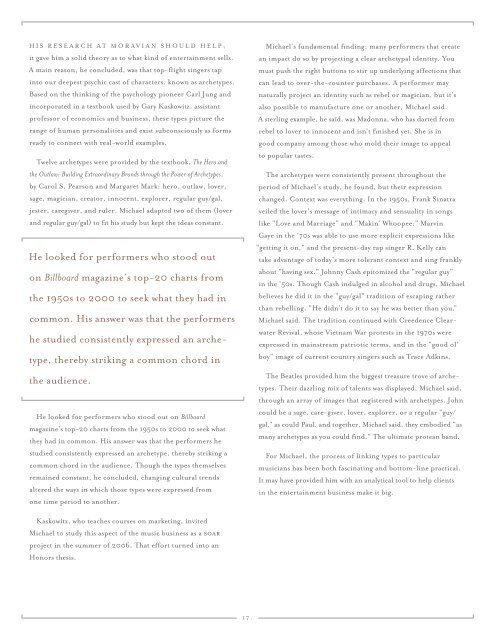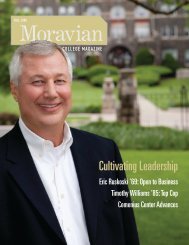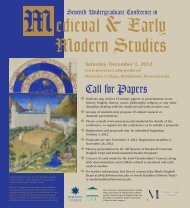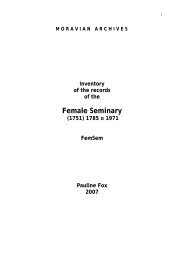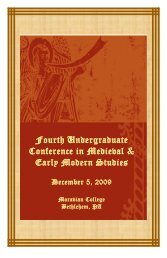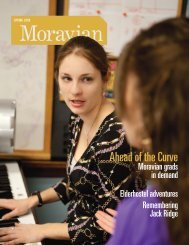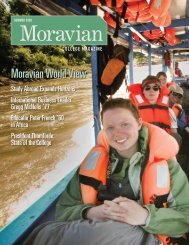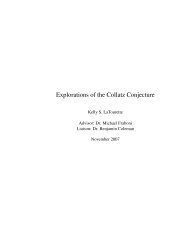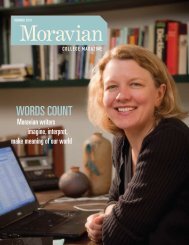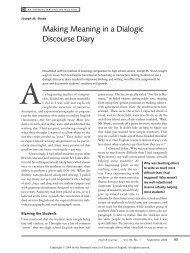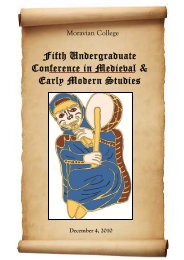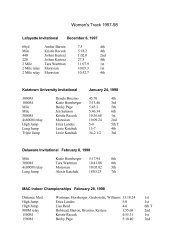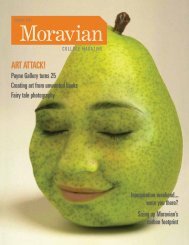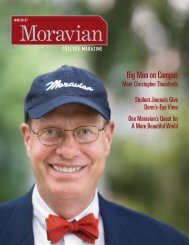Create successful ePaper yourself
Turn your PDF publications into a flip-book with our unique Google optimized e-Paper software.
hIS reSeArCh AT MorAvIAn ShoULd heLP;<br />
it gave him a solid theory as to what kind of entertainment sells.<br />
A main reason, he concluded, was that top-flight singers tap<br />
into our deepest psychic cast of characters, known as archetypes.<br />
based on the thinking of the psychology pioneer Carl Jung and<br />
incorporated in a textbook used by gary kaskowitz, assistant<br />
professor of economics and business, these types picture the<br />
range of human personalities and exist subconsciously as forms<br />
ready to connect with real-world examples.<br />
Twelve archetypes were provided by the textbook, The hero and<br />
the outlaw: Building extraordinary Brands through the power of archetypes,<br />
by Carol S. Pearson and Margaret Mark: hero, outlaw, lover,<br />
sage, magician, creator, innocent, explorer, regular guy/gal,<br />
jester, caregiver, and ruler. Michael adapted two of them (lover<br />
and regular guy/gal) to fit his study but kept the ideas constant.<br />
he looked for performers who stood out<br />
on Billboard magazine’s top-20 charts from<br />
the 1950s to 2000 to seek what they had in<br />
common. his answer was that the performers<br />
he studied consistently expressed an arche-<br />
type, thereby striking a common chord in<br />
the audience.<br />
he looked for performers who stood out on Billboard<br />
magazine’s top-20 charts from the 1950s to 2000 to seek what<br />
they had in common. his answer was that the performers he<br />
studied consistently expressed an archetype, thereby striking a<br />
common chord in the audience. Though the types themselves<br />
remained constant, he concluded, changing cultural trends<br />
altered the ways in which those types were expressed from<br />
one time period to another.<br />
kaskowitz, who teaches courses on marketing, invited<br />
Michael to study this aspect of the music business as a soar<br />
project in the summer of 2006. That effort turned into an<br />
honors thesis.<br />
17.<br />
Michael’s fundamental finding: many performers that create<br />
an impact do so by projecting a clear archetypal identity. You<br />
must push the right buttons to stir up underlying affections that<br />
can lead to over-the-counter purchases. A performer may<br />
naturally project an identity such as rebel or magician, but it’s<br />
also possible to manufacture one or another, Michael said.<br />
A sterling example, he said, was Madonna, who has darted from<br />
rebel to lover to innocent and isn’t finished yet. She is in<br />
good company among those who mold their image to appeal<br />
to popular tastes.<br />
The archetypes were consistently present throughout the<br />
period of Michael’s study, he found, but their expression<br />
changed. Context was everything. In the 1950s, frank Sinatra<br />
veiled the lover’s message of intimacy and sensuality in songs<br />
like “Love and Marriage” and “Makin’ Whoopee.” Marvin<br />
gaye in the ’70s was able to use more explicit expressions like<br />
“getting it on,” and the present-day rap singer r. kelly can<br />
take advantage of today’s more tolerant context and sing frankly<br />
about “having sex.” Johnny Cash epitomized the “regular guy”<br />
in the ’50s. Though Cash indulged in alcohol and drugs, Michael<br />
believes he did it in the “guy/gal” tradition of escaping rather<br />
than rebelling. “he didn’t do it to say he was better than you,”<br />
Michael said. The tradition continued with Creedence Clearwater<br />
revival, whose vietnam War protests in the 1970s were<br />
expressed in mainstream patriotic terms, and in the “good ol’<br />
boy” image of current country singers such as Trace Adkins.<br />
The beatles provided him the biggest treasure trove of archetypes.<br />
Their dazzling mix of talents was displayed, Michael said,<br />
through an array of images that registered with archetypes. John<br />
could be a sage, care-giver, lover, explorer, or a regular “guy/<br />
gal,” as could Paul, and together, Michael said, they embodied “as<br />
many archetypes as you could find.” The ultimate protean band.<br />
for Michael, the process of linking types to particular<br />
musicians has been both fascinating and bottom-line practical.<br />
It may have provided him with an analytical tool to help clients<br />
in the entertainment business make it big.


